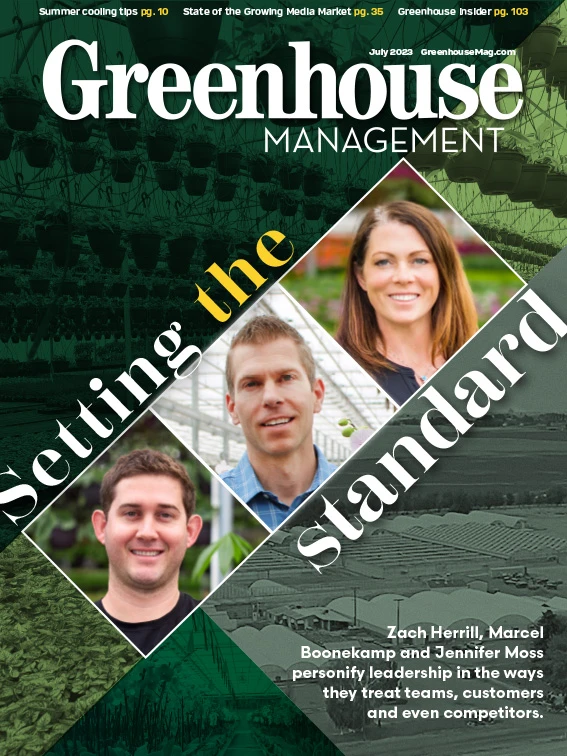Neil Devaney, national sales manager at Stuppy Greenhouse Manufacturing
Greenhouse Management: Where is the ornamental business at right now, in your opinion?
Neil Devaney: It’s always growing, it’s always growing. There are more retail outlets, more customers.
GM: Where is demand coming from right now?
ND: It’s both [ornamental and CEA]. We don’t do any cannabis at Stuppy. Our business is 70% ornamental and nursery growers, and the rest comes from CEA. There are always projects. It depends on the state of the industry. In times where there’s slowdown in the industry or something like that, customers will still invest in their facilities for renovation or energy upgrades. New coverings too. Make repairs. So that continues to happen.
GM: Last year and going back into COVID, one of the big issues was supply chain. What is the supply chain right now?
ND: It’s more normal on most items. Prices are up based on inflation. But if we pay for it, we can get it now.
GM: With trade shows, those took a hit during COVID. Did some time away change how you guys do business and how you utilize trade shows?
ND: We continue to do trade shows. The change from COVID for us, the advantage for us is adoption of technologies to talk to our customers. What I mean by that is that they are much more open to having a conference call rather than us having to travel to their facility. So we can be much more efficient. But that’s with prospecting and with existing clients.
GM: Do you travel less than you used to?
ND: I think we travel slightly less than [we did before COVID]. This does allow me to be more efficient. I am a road warrior kind of guy, so I like traveling. But this allows me to be more efficient and responsive to customers. ... When I first got in the business, to do a proposal, we’d have to mail it and wait a week. And then fax machines started and we could just say ”alright, I’ll fax it to ya.” And then it was like ”you’ve got email, let me email it to ya.” This is just the next transition.
GM: When you look at where the greenhouse manufacturing industry is at, do you expect to see more consolidation?
ND: It’s hard to say. Consolidation will probably continue. But you’re looking at that over the next five years. There’s definitely venture capital with interest the horticultural sector — especially the vegetable, CEA sector — so there’s more visibility for our industry. That could keep popping off at any time.
GM: What do the California energy code changes mean for the industry?
ND: It will certainly spread elsewhere because it will be adopted across the country, I’m sure. Where it will impact growers and garden centers the most is in customers that want to use single pane glass for light in Northern areas, it’s going to impact them having to go to a double glaze material. In the southern part of the U.S. — Texas, parts of California, Florida — where they use single layer plastics, either corrugated or single layer poly, they’ll be impacted the soonest.
And that’s growers secondary to retailers. Retail garden centers will be impact prior to growers. It depends specifically on the local code officials. Garden centers will be [affected first] because they will be in cities and municipalities that don’t necessarily deal with greenhouses often and they’ll be more focused on commercial codes and energy codes for commercial structures. And so, a garden center being open to the public, while it’s a greenhouse a lot of the time, the code official will look for guidance from the codes and follow them more strictly.
Matt Bonavita, president, North America for Ludvig Svensson
Greenhouse Management: What have you seen in the greenhouse market this past year, both as a whole and also at your own business?
Matt Bonavita: There have obviously been a lot of major events in the past few years and people are still recovering from them. The conflict in Ukraine came right after COVID-19. Our economy has been struggling. Of course, inflation went up, which means the price of labor and commodities therefore went up and skyrocketed. And that’s overall impacted the growers’ ability to expand or go forward with new builds, and that’s being felt by the industry as a whole, especially here, as we rely on new builds.
GM: What solutions do you offer growers for their challenges?
MB: One of the biggest challenges for North America is the energy crisis. Growers are just paying more than ever for energy and there doesn’t seem to be any sign of drastic price decreases. We’ve even heard of some growers skipping production cycles and we’ve learned a lot about rebates that we’re pushing throughout the U.S. and Canada, which helps alleviate some of the financial burden and helps bring costs down. As far as light abatement challenges, there are laws for light abatement spreading throughout Canada and that puts the growers in a tough spot to either comply or be fined.
While there are other issues growers are facing, there are also solutions that we have that can set them up for success in the long-term. And that’s what our R&D and consultants focus on, and we launch new solutions to support growers as they navigate these challenges.
GM: What trends are you keeping an eye out for right now?
MB: There’s been a lot of talk about sustainability for years and there’s going to be a lot of talk about it for years to come. We see that people are really starting to connect on that topic. The U.S. and Europe have put forth probably trillion-dollar investment strategies and the U.S. plans are in law already. So you have the high energy use growing sector with the high energy bills, which means a shorter return on investments for energy saving measures. At the same time, billions of dollars in grants and funding are available through the Department of Agriculture. If our customer has signed up for sustainable development goals, they’re looking for alignment from their suppliers, so less CO2, less chemicals and less water usage.
GM: What else have you been hearing from your customers lately?
MB: We remind them everybody’s going through tough times and they’re not in it alone and that there are so many tools and resources available to support growers. That’s really what we’re hearing: “How can you help me?” They know what they’re doing, obviously, but then when we come out with some things that can help them, they’re curious to see what types of products and solutions we’ve designed that can help them. That’s their goal. We have solutions that we designed to create that optimal climate that ends up being perfect for each of these unique crops. For example, we have Luxous, which is an energy savings screen, and ClimaFlow, which is a dehumidification company we acquired. These are solutions that help growers save additional energy in up to the double digits. We’re here to support our customers in meeting those goals and sharing the knowledge of our experienced consultants so they can elevate their production for years to come. It’s just a matter of us getting it out there and saying, “Open your door to us and let us help you.” We’re not here to just sell something.
GM: What do you think the future of the industry looks like?
MB: I think there’s definitely a turning point in the situation of the market. I think there’s high interest in greenhouse cultivation. More investors are looking into the horticulture industry since greenhouse cultivation is enabling higher production and quality through detailed and precise climate control. And for the data-driven investors, I think growers have a lot of potential when they use their climate data to optimize that indoor climate management and screening strategy. So, you know, going back to the energy monitor and ROI calculators, that’s going to help and that’s what the future is looking like for the data-driven people. And then the last thing I would say would be about retail demand. They demand a high level of consistency, size and quality all within the produce. There’s more demand for locally produced items. So there’s going to be a turning point. I’d say there’s high interest in greenhouse cultivation. There’s retail demand and there’s a high focus on data-driven results and value.

Explore the July 2023 Issue
Check out more from this issue and find your next story to read.
Latest from Greenhouse Management
- pH Helpers
- Society of American Florists accepting entries for 2025 Marketer of the Year Contest
- Sustainabloom launches Wholesale Nickel Program to support floriculture sustainability
- American Horticultural Society welcomes five new board members
- Color Orchids acquires Floricultura Pacific, becoming largest orchid supplier in U.S.
- American Floral Endowment establishes Demaree Family Floriculture Advancement Fund
- The Growth Industry Episode 3: Across the Pond with Neville Stein
- 2025 State of Annuals: Petal power








